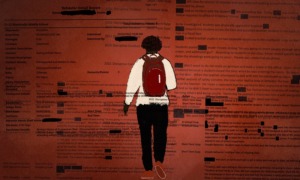Story courtesy of The Chicago Bureau.
CHICAGO — Every fall, when Jeff Frecka teaches health to his class of ninth graders, he knows exactly what the Chicago public school system expects from him.
Frecka, physical education teacher at Mather High School in the Lincoln Square neighborhood of Chicago, said all freshmen are required to take one semester of health education, which covers nutrition, drugs and alcohol, decision-making, body systems, sex education and contraception.
 The way the PE teacher approaches these topics, however, is entirely up to the teacher. And when it comes to the classic debate over STD education, Frecka is never quite sure of the right approach.
The way the PE teacher approaches these topics, however, is entirely up to the teacher. And when it comes to the classic debate over STD education, Frecka is never quite sure of the right approach.
“Our students have so many misconceptions about just about everything,” Frecka said. “They’re just not getting enough information … it can be overwhelming.”
Frecka’s problem is shared by thousands of Chicago Public Schools teachers trying to create sex education curricula consistent with a city-wide education policy that leaves much open to interpretation.
“Usually in public schools, the task of sex education falls on gym teachers, and it’s entirely up to them how they want to present the curriculum,” said Steven Gillenwater, a counselor at the Rush Adolescent Family Center, a juvenile health clinic in downtown Chicago. Schools across the Chicago metropolitan area hire Gillenwater to teach specialized classes on STDs and contraception. “Whatever the teacher doesn’t want to talk about, they don’t talk about … so across the city it’s really hit-or-miss depending on the teacher.”
CPS policy, according to the district, is to “not exclude any information required to provide instruction designed to promote a wholesome and comprehensive understanding of the emotional, psychological, physiological, hygienic and social responsibility aspects of adult life.”
Despite the policy’s lack of specificity, the City of Chicago has mandated comprehensive sex education for many years, beginning in the 1980s, said CPS spokesman Franklin Shufton. Although many believe the policy should provide more guidance for health teachers when it comes to talking about sex, it’s more thorough than the sex education curricula offered by other school districts around the country.
“The Chicago Public Schools, bless their hearts, are great believers in comprehensive sex education, and it would be very nice if we could get that statewide … and nationwide, for that matter,” said Ann Hilton Fisher, executive director of the AIDS Legal Council of Chicago. “And so there is a big push in Springfield to require school districts to do what Chicago does. It’s a great model, obviously not 100 percent effective, but the attitude is right.”
At the same time, an ardent traditionalist faction within the city has kept abstinence education a high priority for CPS. After all, CPS policy “emphasizes abstinence as the expected norm.” Gillenwater added that, abstinence-only school health policies still exist as a heavy burden to STD prevention in the city.
“There are a lot of schools in the Chicago area, particularly in the suburbs, that like to believe they can keep their students from having sex and teach them as such,” he said. “There’s been no point in human history when teenagers weren’t having sex, and it amazes me when schools think they can stop them now.”
On a national level, Gillenwater said, he has observed higher incidences of sexually transmitted diseases and teen pregnancy in areas where the population opposes comprehensive sex education. This trend is exemplified in Texas, a state known for its far-reaching abstinence-only education policy that also has the fourth highest HIV contraction rate and second highest teen pregnancy rate in the country, according to the Centers for Disease Control and Prevention.
CPS’ focus on abstinence isn’t the only hole in its “comprehensive” sex education policy, Gillenwater said. The city-wide mandate only applies to high schools, meaning that students could complete the eighth grade without any health education whatsoever.
“In urban high schools, teachers tend to value sex education and we see an effort for more comprehensive curricula because those are the places where they’re seeing kids get pregnant and contract STDs,” Gillenwater said. “Middle schools and more suburban schools, we’ve seen, won’t touch the issue with a 10-foot pole because they don’t see the problem and therefore don’t think it exists.”
Adrienne Cirrincione has observed this phenomenon firsthand in her 12 years as physical education chair of Northside College Prep, a selective public school on Chicago’s Northwest Side that enrolls students from middle schools across the city.
“We have so many students coming in who’ve gotten so much conflicting information from so many different people, and we know that kids aren’t talking to their parents about this stuff,” Cirrincione said. “They come into my class and they still think you can get HIV by touching someone … they just don’t understand the difference between bacterial and viral diseases.”
For Gillenwater, ignorance about sexual health among CPS students is an easily preventable problem.
“Sex education is just like reading or math — the earlier you start teaching it, the better it’s going to work,” he said. “And the sooner CPS understands that, the sooner the city might start seeing a reduction in its infections and teen pregnancy.”
Alex Nitkin is a writer for The Chicago Bureau.
























